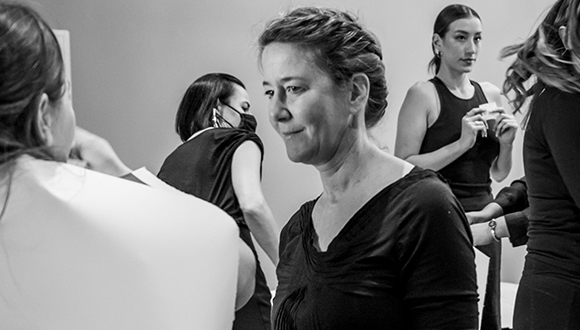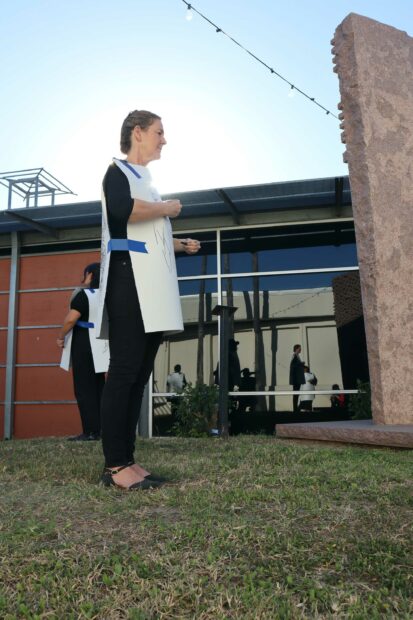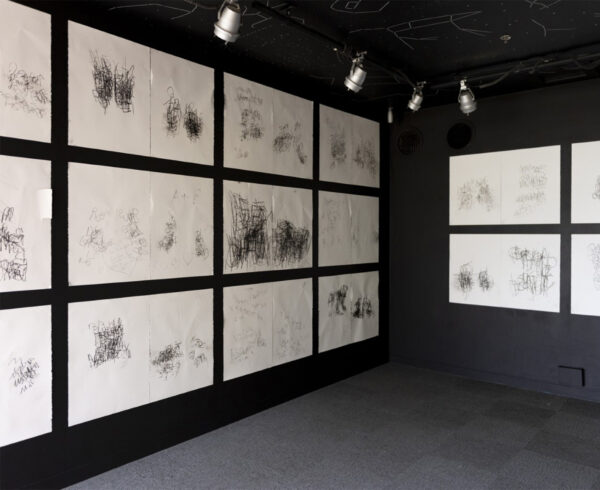
Jana Harper listening to a UTRGV MFA student before performing “Not the
First Nor the Last” at the IMAS, March 26, 2022. Photo courtesy of Carlos Limas
Jana Harper is an interdisciplinary and video performance artist who explores transcendence, materiality, and human connectivity through movement, sculpture, and collaboration. She is an Associate Professor of the Practice in the Department of Art at Vanderbilt University in Nashville, Tennessee. While Harper has participated in over 12 individual or two-person shows, as you get to know her in this interview, it becomes clear her practice involves de-centering herself by collaborating with others.
I met Harper during her artist talk launching the event series connected to Uncovered Spaces, an exhibition of women and LGBTQIA+ artists at the International Museum of Art & Science (IMAS) in McAllen, Texas. Harper visited the University of Texas Rio Grande Valley (UTRGV) after being introduced by exhibition curator Raheleh Filsoofi and Dr. Katherine Moore McAllen, who serves as the director of the UTRGV Center for Latin American Arts and Uncovered Spaces. On February 9, 2022, Harper presented her artist talk. She also visited with community members, university students, and faculty in the School of Art & Design in Edinburg and Brownsville, Texas. Harper invited University of Texas Rio Grande Valley (UTRGV) students, faculty, staff, and their families to participate in two performance pieces as part of the Uncovered Spaces exhibition This exhibition was open at the IMAS museum from March 26 to July 10, 2022.
Kathy Bussert-Webb (KBW): Can you describe your experience participating in the Uncovered Spaces exhibition?
Jana Harper (JH): I had an incredible experience. The real gift of Uncovered Spaces was having the space and the support to develop these two projects in the community. They had been exhibited in different versions, but only in relation to my personal story. So it was kind of a leap of faith to see if it would work with more people and with larger ideas connecting ancestry and place. At one point the students asked me what it was like “the other times I did it” and I had to tell them, “No, this is the first time. We are really doing this together.”
But the thing about community-engaged work is that it takes an actual community for it to work. So, from an organizational standpoint, Raheleh Filsoofi [Uncovered Spaces‘ curator] and Katherine McAllen [Exhibition Director at UTRGV Center for Latin American Arts), the staff at CLAA, the IMAS, and the UTRGV students and faculty made it really easy. In some ways I feel like I just introduced the seed, but everyone else planted, watered, and now, are hopefully sowing the results. This work now belongs to the community. Both the video and the room of performance drawings displayed the hands and the marks and the ancestry of the participants. Hopefully, they’re getting to share their stories with their friends and families as a result.
KBW: It seems like you connected with students in the Rio Grande Valley. You met high school students and UTRGV students as part of two performances and during your artist talk. Can you share any particular story about these encounters?
JH: Maybe it’s just a byproduct of the pandemic, but it’s been a while since I’ve had the opportunity to engage with so many people in person, and I was struck by how actively attentive and present all the students were. I loved visiting Gina Palacios’ painting class in Brownsville. We did a test run of the drawing performance and not only was it fun and lively, but people were asking really tough questions about the nature of family, acknowledging what a privilege it is to know who our families are, and even questioning what names we are allowed to share or what risks might be associated with sharing those names.
When I was editing the video that Carlos Limas captured of people writing their ancestors’ names in water, I was really interested in the conversations going on in the background – people with shared names wondering if they were somehow related, people telling little gems about their grandma or great-grandma, and just hearing people connect over a shared experience. It felt really special.

Jana Harper performing at the opening of “Uncovered Spaces” at IMAS International Museum of Art and Science in McAllen
KBW: How did your visit to the Rio Grande Valley impact your practice?
JH: I think that taking risks is a practice, something you have to do over and over again, because each time you learn something new. Looking back, I’ve been thinking about the hour I spent with the participants before the performance when we were getting ready (or even the 20 minutes getting the high schoolers ready). In some ways that period is a blur, but my memory of it is really strong. We became one body working together. The participants were taking a risk, but they floored me because they brought their whole hearts to the activity. Embedded in the risk was a tremendous amount of trust. I love the sensation when the individual disappears and becomes part of something larger than themselves, and I really felt that working in the Valley.
One of the great pleasures of traveling and visiting different communities is that you get a chance to break the narrative from the network news. Texas is represented pretty narrowly, which is unfortunate because it’s such a diverse and nuanced state. I loved learning about the rich history of the Rio Grande Valley, and the generational presence of so many families that even pre-dates the formation of the United States. The East Coast gets so much attention for being “old,” but every region is “old” in its own way. I thought a lot about the Northern border and the ways that Indigenous and Native families have had to continuously navigate political borders there. That connection is something I’d like to continue to investigate.
KBW: You have made socially-engaged art in the U.S. and in Matanzas, Cuba. In Matanzas you created a piece called Cargos, which means loads or burdens. In your artist talk, you mentioned participants writing on chairs about their burdens.
JH: The two pieces you’re talking about are rooted in similar research centered around the questions, “What are the burdens we carry?” And then, “What might they look like or how could we represent them?” When I travel around and do workshops with different groups, we begin by making a list to answer those questions. We brainstorm all of the things that people might experience as burdens, from very personal things like dealing with aging parents to much more global, political things like climate change. And then we choose a prop.
Often chairs are a really great prop. They have such a wonderful lineage from Paolo Freire, Augusto Boal, and community-engaged theater. Workshop participants choose one thing off of the list, write it on a piece of paper, and place the paper on the chair. Then I give them a series of movement prompts, varied ways of being in relationship with their burden. This does a couple of things: it externalizes the burden so witnesses can experience it, and it removes the burden from the participant’s body so it can be engaged on different terms.
This can lead to a transformational experience. As an example, during a workshop at UC Berkeley, students put all their [chair] burdens in this crazy big pile and then somebody spontaneously took off their shoe and threw it at the pile. And then everybody was throwing their shoes until the whole pile collapsed. It was chaotic and beautiful and had a sense of agency.
KBW: I remember in your artist talk you mentioned that participants in Cuba were looking around and trying to figure out what objects might be possible, and you all decided on ration bags.
JH: So for the performance that I worked on in the states [This Holding], we used repurposed clothing. I was going to thrift stores and buying pants and sweaters and then stuffing them with buckwheat, which is quite heavy. But the thing was, that didn’t seem appropriate in Cuba. The ration bags that originally transported rice and other staples are repurposed for all kinds of things. They’re used in construction, they’re filled with sand, and they’re used by fruit sellers. And so they already represented a system that seemed important for us to reference.
KBW: So when you were in Cuba, you were talking about lineage. Can you say more about this? I’m thinking about Cuba and the people there being of many different cultures. So, there is the Spanish-colonial influence, and people of African descent displaced by the slave trade — the mashing up of diverse cultures. Is that what you’re referring to?
JH: Partly. I feel like I come from a culture where it’s okay to leave your family. My family is spread out all over the place and there’s no expectation or value in sticking close together. There’s such an individualism or an individualistic way of approaching life and career. We live all over, and we might not even know the names of our ancestors. In my experience in Cuba, families were more connected with each other; communities maintained a collective memory of events and histories. I think that we experience more of a cultural amnesia because we don’t collectively remember. There’s such a grand erasure in our culture, like the “don’t say gay” bill or the denial of critical race theory. There are all these ways that American culture is more about erasure than about preservation. I want to think about it in terms of indigenous lineage and collective memory-keeping.
KBW: Do you think of your work as socially-engaged art?
JH: I try to avoid defining it because I find the definitions problematic in one way or another. I think someone was asking about social practice and he was like, “do you call yourself a social practice artist?” And I was like, “no.”
I do think that an aspect of community engagement has been present in my work for quite a long time. I work with interviews. In my background as a printmaker, there’s a lot of community inclusivity that shows up in different ways. I find that those definitions and divisions are often used by other people when they’re trying to define someone’s practice or market them. These definitions are rooted in capitalism, so I’m wary of them.
KBW: Why is that?
JH: Well, printmaking is rooted in democracy, especially letterpress. The way that printmakers work is really community-minded, because we have to share equipment. Most people don’t own their own presses. So you have to come together and figure out ways to work together or work in complementary ways. And there are all these mechanisms in printmaking where people engage and communicate and collaborate with each other, from print portfolios to just working jointly on a print together. That’s what my degree was in, and what I taught for 13 years, so I was deeply engaged in those communities. And then when I came to Nashville, my department didn’t have a letterpress, and they weren’t interested in artist books, so I had the opportunity to reinvent myself and pursue the other things that I love and am interested in.
KBW: You said you participated in interviews. Do you mean interviews like the one we’re doing right now? How does that involve the community?
JH: The interview shows up in my work a lot, and it has to do with my own incessant curiosity. But I’ll just give you one example. I worked on a project called You Call It A Cloud, where the central image was a photo that my mom had taken of a lenticular cloud sitting on Mount Blanca in southern Colorado. I showed that image to a range of people whose occupations keep them in regular contact with the sky, particularly in that region. I interviewed a micro-climatologist, a flight instructor, a rancher, a philosopher, and a shaman. I showed them the photo and asked them to read it from their perspective and tell me what they saw in it. And then I made a publication. There’s the photo on one side, and then there are excerpts from all the texts, from all the interviews on the other side.
The idea is that nothing is ever one thing, depending on perspective and context. Something as simple as a cloud can have multiple interpretations. And that’s something that I’m fundamentally interested in — how there can be multiple understandings of the truth, simultaneously. And I would maybe put “truth” in quotation marks. It’s always subjective, but there are parallel truths. So how do you represent that in visual artwork? For me, sometimes it just comes down to transcribing interviews. I’ve done it in different circumstances. I was a fellow at the Elsewhere Museum, and I did a project there that involved interviewing and transcribing. I’m also starting to work on a project that centers around concepts of recognition. In philosophy there’s something called recognition theory. In politics, it involves nation to nation recognition.
KBW: What in your past got you so interested in this undefinable thing? I don’t even know if I want to use the words “community engagement.” What got you inspired?
JH: I would say a couple of different family experiences. My dad is a big inspiration. He grew up on a farm and went to college and moved to Washington, D.C. in direct response to President Kennedy’s challenge to the country.
KBW: “What can you do for your country?”
JH: Exactly. So my dad heeded that call and became a career civil servant; he worked for the Environmental Protection Agency. But he had a value of service that he passed on to all of us. He married someone when I was six who had an equal commitment to community and service. So, in 1979 or 1980, right after the Vietnam War, there was a huge influx of Southeast Asian refugees in our community outside of Washington, DC., and my stepmother became involved. There were always refugees in our house. We had a mattress propped up behind the couch in the family room. There might be someone that came for a weekend before they resettled. There was one guy who lived with us for nine months. Then this young boy came, and my parents ended up adopting him, so he became our brother. And so, their involvement and engagement — particularly with the Cambodian community — had a really profound impact on me. I would say between that and my dad’s sense of service, it was always important for me to figure out ways to decenter myself in my own work. I think that decentering becomes even more important as I mature, as the work matures, and in relation to decolonization.
****
This interview has been lightly edited for length and clarity.
Uncovered Spaces was on view at the IMAS from March 26 to July 10, 2022. To learn more about Uncovered Spaces, please go here and here.
Dr. Kathy Bussert-Webb received an MFA in Studio Art from UTRGV. She is Professor Emeritus in UTRGV’s Bilingual and Literacy Studies Department. You can reach her @3DbyKathy on Instagram.



